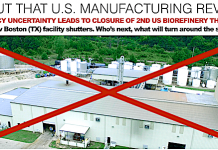by Debra Fiakas CFA
Earlier this week FutureFuel Corporation (FF: NYSE) reported financial results for the second quarter ending June 2015. Sales of the company’s biodiesel and specialty chemical products increased 53.7% to $104.6 million compared to the prior-year quarter when reported revenue was $68.0 million. The company delivered a profit as usual, but traders appeared unimpressed. The stock gapped lower on the news and two days later set a new 52-week low price. Granted net income was lower year-over-year by 30.9%, coming in at $3.8 million or $0.09 per share.
A closer look at the sales mix reveals what has FutureFuel shareholders gnawing their nails.
Sales of the company’s various chemical products were essentially flat in the June quarter after registering a 13.0% leg higher year-over-year in the March quarter. The June quarter plateau should not have come as a surprise given that the chemicals segment has been erratic at best, shrinking in 2013 after registering weak growth in 2012.
Chemical products include an diverse mix of herbicides, industrial formulas and a bleach activator. Historically, the bleach activator has been FutureFuel’s bread winner, responsible for 15% to 20% of total sales over the last few years. In the June quarter sales of this product dropped to just 6% of total sales. The bleach activator is used in powdered laundry detergents, which have lost market share to liquid detergents in recent years. FutureFuel’s primary customer for this product is terminating its order arrangement by the end of 2015. Management has claimed negotiations are still underway, but if sales in the June quarter are any indication, a new supply agreement is not likely.
Orders for other chemicals helped make up the short-fall in bleach activator revenue. Sales volume of proprietary herbicides doubled in the June quarter compared to the same quarter last year. However, revenue increased only 75%, which the company attributed to ‘product mix.’ Apparently, certain contributors to the elevated volumes were lower priced items. Revenue also increased 25% for intermediate chemicals used in the production of antimicrobial solutions and other custom chemicals. As encouraging as these revenue pick-ups might be, the loss of a major customer for a principle product is certainly a ‘fret’ worthy turn in events.
This brings us to the biofuels segment, which contributed $71.9 million in total sales to the June quarter, representing 3.6 times biofuel revenue in the previous quarter and 2.0 times revenue the year-ago period. Increased sales through common carrier pipelines offset volume declines in the June quarter. The revenue accomplishment should have shareholders squat jumping high-fives! Unfortunately, profits in the biofuel segment were nothing to celebrate.
FutureFuel reported a gross profit margin of 10.2% in the biofuel segment in the year 2014, and the profit margin increased to 12.3% in the first quarter this year. However, in the June quarter pricing pressures got the best of FutureFuel, gobbling up profits and leaving the company with a profit margin of negative 6.2%. In other words, it cost FutureFuel more to produce its biofuel products than it recorded in sales. Management cited erosion in selling prices for transportation fuel and uncertainly in U.S. regulatory mandates for renewable fuels.
Few if any analysts or economists are predicting a near-term recovery in crude oil prices. What is more, in the lead up to elections no one should hold their breath waiting for Congress to set policy on much of anything let alone renewable fuels standards. Thus it seems shareholders could expect more of the same volume and profit dynamic in coming quarters for FutureFuel’s biofuel segment. This is definitely something to fret about.
Top-line stress is probably not the only factor sending FutureFuel shares into free fall. Operating cash flow reveals more reasons for FutureFuel shareholders to worry. The company generated $41.1 million in operating cash in the first three months of 2015. However, in the June quarter FutureFuel actually used $6.2 million of its cash resources to support operations. This is not a positive turn of circumstances. While the company saved some cash by drawing down inventory by $8.5 million in the quarter, approximately $7.2 million in reported sales got bogged down in accounts receivable. Another $7.9 million in cash was lodged during the quarter in an income tax receivable. The company also paid down accounts receivable by $980,000.
The ebb and flow of working capital accounts only creates temporary cash flow problems. For FutureFuel it is really the quality of earnings that should worry shareholders. The company reported $3.8 million in net income in the quarter, but a total of $1.8 million or 47% came from a mix of non-operating sources: $627,000 came from a deferred income tax benefit, $770,000 from increased value in marketable securities, and $450,000 from the sale of investments.
FutureFuel has traded to a record low for the year, taking the price to an enticing 7.8 times trailing earnings. The dividend yield is a very interesting 2.4% at the current price. With $142.0 million in cash and another $85.9 million in marketable securities on the balance sheet, the company appears capable of withstanding a few more quarters of negative operating cash flows before the dividend would come under scrutiny.
For investors with a long-term time horizon, the dividend yield could be a good reason to fret less about the last quarter and look more carefully at the company on the basis of annual sales, profit margins and cash flows. The temporary influences that make the quarter results look exceptionally good or bad get smoothed out. The erosion in profit margins cannot be escaped by looking at full-year comparisons, but a dividend check helps make worthwhile the wait for resumption in sales growth.
Debra Fiakas is the Managing Director of Crystal Equity Research, an alternative research resource on small capitalization companies in selected industries.
Neither the author of the Small Cap Strategist web log, Crystal Equity Research nor its affiliates have a beneficial interest in the companies mentioned herein.







